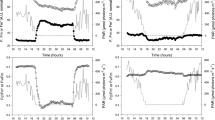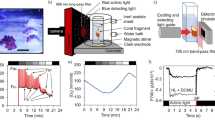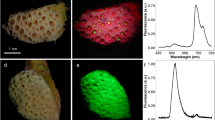Abstract
Mass coral bleaching is linked to elevated sea surface temperatures, 1–2 °C above average, during periods of intense light. These conditions induce the expulsion of zooxanthellae from the coral host in response to photosynthetic damage in the algal symbionts. The mechanism that triggers this release has not been clearly established and to further our knowledge of this process, fluorescence rise kinetics have been studied for the first time. Corals that were exposed to elevated temperature (33 °C) and light (280 μmol photons m−2 s−1), showed distinct changes in the fast polyphasic induction of chlorophyll-a fluorescence, indicating biophysical changes in the photochemical processes. The fluorescence rise over the first 2000ms was monitored in three species of corals for up to 8 h, with a PEA fluorometer and an imaging-PAM. Pocillopora damicornis showed the least impact on photosynthetic apparatus, while Acropora nobilis was the most sensitive, with Cyphastrea serailia intermediate between the other two species. A. nobilis showed a remarkable capacity for recovery from bleaching conditions. For all three species, a steady decline in the slope of the initial rise and the height of the J-transient was observed, indicating the loss of functional Photosystem II (PS II) centres under elevated-temperature conditions. A significant loss of PS II centres was confirmed by a decline in photochemical quenching when exposed to bleaching stress. Non-photochemical quenching was identified as a significant mechanism for dissipating excess energy as heat under the bleaching conditions. Photophosphorylation could explain this decline in PS II activity. State transitions, a component of non-photochemical quenching, was a probable cause of the high non-photochemical quenching during bleaching and this mechanism is associated with the phosphorylation-induced dissociation of the light harvesting complexes from the PS II reaction centres. This reversible process may account for the coral recovery, particularly in A. nobilis.
Similar content being viewed by others
References
Barthélemy X, Popovic R and Frank F (1997) Studies on the O–J–I–P transient of chlorophyll fluorescence in relation to Photosystem II assembly and heterogeneity in plastids of greening barley. J Photochem Photobiol B Biol 39: 213–218
Brown BE (1997) Coral bleaching: causes and consequences. Coral Reefs 16: 129–138
Brown BE, Dunne RP and Chansang H (1996) Coral bleaching relative to elevated seawater temperature in the Andaman Sea (Indian Ocean) over the last 50 years. Coral Reefs 15: 151–152
Bruno JF, Siddon CE, Witman JD, Colin PL and Toscano MA (2001) El Niño related coral bleaching in Palau, Western Caroline Islands. Coral Reefs 20: 127–136
Büchel C and Wilhelm C (1993) In vivo analysis of slow chlorophyll fluorescence induction kinetics in algae: progress, problems and perspectives. Photochem Photobiol 58: 137–148
Cook CB, Logan A, Ward J, Luckhurst B and Berg CJ (1990) Elevated temperatures and bleaching on a high-latitude coral reef: the Bermuda event. Coral Reefs 9: 45–49
Dau H (1994) Molecular mechanisms and quantitative models of variable Photosystem II fluorescence. Photochem Photobiol 60: 1–23
Demmig-Adams B and Winter K (1988) Characterisation of three components of non-photochemical fluorescence quenching and their response to photoinhibition. Aust J Plant Physiol 15: 163–177
Demmig-Adams B, Winter K, Krüger A and Czygan F (1989) Light response of CO2 assimilation, dissipation of excess excitation energy, and zeaxanthin content of sun and shade leaves. Plant Physiol 90: 881–886
Fitt WK and Warner ME (1995) Bleaching patterns of four species of Caribbean reef corals. Biol Bull 189: 298–307
Fitt WK, Brown BE, Warner ME and Dunne RP (2001) Coral bleaching: interpretation of thermal tolerance limits and thermal thresholds in tropical corals. Coral Reefs 20: 51–65
Glynn PW (1984) Widespread coral mortality and the 1982–1983 El Niño warming event. Environ Conserv 11: 133–146
Glynn PW, Mate JL, Baker AC and Calderon MO (2001) Coral bleaching and mortality in Panama and Ecuador during the 1997–1998 El Niño-Southern Oscillation event: spatial/temporal patterns and comparisons with the 1982–1983 event. Bull Mar Sci 69: 79–109
Govindjee (1995) Sixty-three years since Kautsky: chlorophyll a fluorescence. Aust J Plant Physiol 22: 131–160
Guissé B, Srivastava A and Strasser RJ (1995) The polyphasic rise of the chlorophyll a fluorescence (O–K–J–I–P) in heat stressed leaves. Arch Sci (Geneva) 48: 147–160
Haldrup A, Jensen PE, Lunde C and Scheller HV (2001) Balance of power: a view of the mechanism of photosynthetic state transitions. Trends Plant Sci 6: 301–305
Hanelt D(1998) Capability of dynamic photoinhibition in Arctic macroalgae is related to their depth. Mar Biol 13: 361–369
Heckathorn SA, Coleman JS and Hallberg RL (1997) Recovery of net CO2 assimilation after heat stress is correlated with recovery of oxygen-evolving-complex proteins in Zea mays L. Photosynthetica 34: 13–20
Hill R, Schreiber U, Gademann R, Larkum AWD, Kühl M and Ralph PJ (2004) Spatial heterogeneity of photosynthesis and the effect of temperature-induced bleaching conditions in three species of corals. Mar Biol 144: 633–640
Hoegh-Guldberg O (1999) Climate change, coral bleaching and the future of the world 's coral reefs. Mar Freshwater Res 50: 839–866
Hoegh-Guldberg O and Salvat B (1995) Periodic mass bleaching and elevated seawater temperatures: bleaching of outer reef slope communities in Moorea, French Polynesia. Mar Ecol Prog Ser 121: 181–190
Iglesias-Prieto R (1995) The effects of elevated temperature on the photosynthetic responses of symbiotic dino flagellates. In: Mathis P (ed) Photosynthesis: from Light to Biosphere, Vol IV, pp 793–796. Kluwer Academic Publishers, Dordrecht, The Netherlands
Jones RJ and Hoegh-Guldberg O (1999) Effects of cyanide on coral photosynthesis: implications for identifying the cause of coral bleaching and for assessing the environmental effects of cyanide shing. Mar Ecol Prog Ser 177: 83–91
Jones RJ and Hoegh-Guldberg O (2001) Diurnal changes in the photochemical efficiency of the symbiotic dino flagellates (Dionphyceae) of corals: photoprotection, photoinactivation and the relationship to coral bleaching. Plant Cell Environ 24: 89–99
Jones RJ, Hoegh-Guldberg O, Larkum AWD and Schreiber U (1998) Temperature-induced bleaching of corals begins with impairment of the CO2 fixation metabolism in zooxanthellae. Plant Cell Environ 21: 1219–1230
Jones RJ, Ward S, Yang AA and Hoegh-Guldberg O (2000) Changes in quantum efficiency of Photosystem II of symbiotic dino flagellates of corals after heat stress, and of bleached corals sampled after the 1998 Great Barrier Reef mass bleaching event. Mar Freshwater Res 50: 839–866
Koblí žek M, Ciscato M, Komenda J, KopeckýJ, Šiffel P and Masojýdek J (1999) Photoadaptation in green alga Spongiochloris sp. A three fluorometer study. Photosynthetica 37: 307–323
Krause GH (1988) Photoinhibition of photosynthesis. An evaluation of damaging and protective mechanisms. Physiol Plant 74: 566–574
Lavergne J and Trissl HW (1995) Theory of fluorescence induction in Photosystem II: derivation of analytical expressions in a model including exciton-radical-pair equilibrium and restricted energy transfer between photosynthetic units. Biophys J 68: 2474–2492
Lavorel J (1959) Induction of fluorescence in quinone-poisoned Chlorella cells. Plant Physiol 34: 204–209
Lavorel J and Etienne AL (1977) In vivo chlorophyll fluorescence. Topics Photosynth 2: 203–268
Lazár D (1999) Review: chlorophyll a fluorescence induction. Biochim Biophys Acta 1412: 1–28
Lazár D (2003) Chlorophyll a fluorescence rise induced by high light illumination of dark-adapted plant tissue studied by means of a model of Photosystem II and considering Photosystem II heterogeneity. J Theor Biol 220: 469–503
Loya Y, Sakai K, Yamazato K, Nakano Y, Sambali H and Van Woesik R (2001) Coral bleaching: the winners and the losers. Ecol Lett 4: 122–131
Lu C and Vonshak A (2002) Effects of salinity stress on Photosystem II function in cyanobacterial Spirulina platensis cells. Physiol Plant 114: 405–413
Marshall PA and Baird AH (2000) Bleaching of corals on the Great Barrier Reef: differential susceptibilities among taxa. Coral Reefs 19: 155–163
Müller P, Li X and Niyogi KK (2001) Non-photochemical quenching. A response to excess light energy. Plant Physol 125: 1558–1566
Munday JC and Govindjee (1969) Light-induced changes in the fluorescence yield of chlorophyll a in vivo III. The dip and the peak in fluorescence transient of Chlorella pyrenoidosa. Biophys J 9: 1–21
Neubauer C and Schreiber U (1987) The polyphasic rise of chlorophyll fluorescence upon onset of strong continuous illumination: I. Saturation characteristics and partial control by the Photosystem II acceptor side. Verl Z Naturf 42: 1246–1254
Pospíšil P and Dau H (2000) Chlorophyll fluorescence transients of Photosystem II membrane particles as a tool for studying photosynthetic oxygen evolution. Photosynth Res 65: 41–52
Ralph PJ, Gademann R and Larkum AWD (2001) Zooxanthellae expelled from bleached corals at 33 °C are photosynthetically competent. Mar Ecol Prog Ser 220: 163–168
Ravindran J, Raghukumar C and Raghukumar S (1999) Disease and stress-induced mortality of corals in Indian reefs and observations on bleaching of corals in the Andamans. Curr Sci 76: 233–237
Schreiber U (2004) Pulse-amplitude-modulation (PAM) fluorometry and saturation pulse method: an overview. In: Papageorgiou GC and Govindjee (eds) Chlorophyll Fluorescence: a Signature of Photosynthesis. Kluwer Academic Publishers, Dordrecht, The Netherlands
Schreiber U and Neubauer C (1987) The polyphasic rise of chlorophyll fluorescence upon onset of strong continuous illumination: II. Partial control by the Photosystem II donor side and possible ways of interpretation. Verl Z Naturf 42: 1255–1264
Schreiber U and Vidaver W (1976) Rapid light-induced changes of energy distribution between Photosystems I and II. FEBS Lett 62: 194–197
Sobrado MA and Ball MC (1999) Light use in relation to carbon gain in the mangrove, Avicennia marina, under hypersaline conditions. Aust J Plant Physiol 26: 245–251
Srivastava A, Guissé B, Greppin H and Strasser RJ (1997) Regulation of antenna structure and electron transport in PS II of Pisum sativum under elevated temperature probed by the fast polyphasic chlorophyll a fluorescence transient: OKJIP. Biochim Biophys Acta 1320: 95–106
Srivastava A, Strasser RJ and Govindjee (1999) Greening of peas: parallel measurements of 77K emission spectra, OJIP chlorophyll a fluorescence transients, period four oscillation of the initial fluorescence level, delayed light emission and P700. Photosynthetica 37: 365–392
Stirbet A, Govindjee, Strasser BJ and Strasser RJ (1998) Chlorophyll a fluorescence induction in higher plants: modelling and numerical simulation. J Theor Biol 193: 131–151
Strasser RJ and Govindjee (1992) The Fo and the O–J–I–P fluorescence rise in higher plants and algae. In: Argyroudi-Akoyunoglou JH (ed) Regulation of Chloroplasts Biogenesis, pp 423–426. Plenum Press, New York
Strasser RJ, Srivastava A and Govindjee (1995) Polyphasic chlorophyll a fluorescence transient in plants and cyanobacteria. Photochem Photobiol 61: 32–42
Trissl HW, Gao Y and Wulf K (1993) Theoretical fluorescence induction curves derived from coupled differential equations describing the primary photochemistry of Photosystem II by an exciton-radical pair equilibrium. Biophys J 64: 974–988
Tsimilli-Michael M, Pêcheux M and Strasser RJ (1999) Light and heat stress adaptation of the symbionts of temperate and coral reef Foraminifers probed in hospite by the chlorophyll a fluorescence kinetics. Verl Z Naturf 54: 671–680
Warner ME, Fitt WK and Schmidt GW (1996) The effects of elevated temperature on the photosynthetic efficiency of zooxanthellae in hospite from four different species of coral reef: a novel approach. Plant Cell Environ 19: 291–299
Williams WP and Allen JF (1987) State 1/state 2 changes in higher plants and algae. Photosynth Res 13: 19–45
Woesik R (2001) Coral bleaching: transcending spatial and temporal scales. Trends Ecol Evol 16: 119–121
Yentsch CS, Yentsch CM, Cullen JJ, Lapointe B, Phinney DA and Yentsch SW (2002) Sunlight and water transparency: cornerstones in coral research. J Exp Mar Biol Ecol 268: 171–183
Author information
Authors and Affiliations
Rights and permissions
About this article
Cite this article
Hill, R., Larkum, A., Frankart, C. et al. Loss of Functional Photosystem II Reaction Centres in Zooxanthellae of Corals Exposed to Bleaching Conditions: Using Fluorescence Rise Kinetics. Photosynthesis Research 82, 59–72 (2004). https://doi.org/10.1023/B:PRES.0000040444.41179.09
Issue Date:
DOI: https://doi.org/10.1023/B:PRES.0000040444.41179.09




